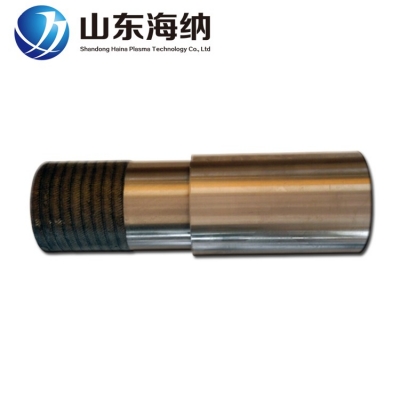Technical introduction: As a refined surface strengthening process, plasma fine cladding can strengthen the inner wall of pipe, hole (inner diameter greater than 70 mm) or the outer surface of workpiece to increase its wear resistance, corrosion resistance and high temperature oxidation resistance. In this process, the substrate is melted by micro-plasma arc, and the alloy powder is fed into the melting pool synchronously. Under the action of plasma arc, convection, homogenization and solidification occur in the melting pool, and a high-performance cladding layer with metallurgical bonding with the matrix is formed.
Technical features: The thickness of the cladding layer obtained by this process can be accurately controlled (1-5mm), with uniform thickness and low dilution rate (about 6%). The cladding layer has high purity, beautiful shape and metallurgical bonding with the substrate, which has high bonding strength. Moreover, the heat input is small and the heat affected zone of the substrate is small. Ultrasound and X-ray were used to detect the full coverage of the cladding workpiece. The results showed that the cladding layer was firmly bonded with the substrate, and there were no pinholes, inclusions and cracks in the cladding layer. The analysis results of electron probe and scanning electron microscopy showed that the alloy elements in the cladding layer were evenly distributed on the cross section of the cladding layer, and the reinforced carbides in the cladding layer were evenly distributed.
Application Conditions: Different powder systems can be selected to treat the workpieces under poor working conditions such as low stress wear, high temperature wear, impact wear and corrosion. The wear resistance of the cladding layer is mainly strengthened by (Fe, Cr) 7C3 with hardness up to HRC68. The wear loss of the cladding layer is only 0.056g according to ASTM-G65 standard. Under the same test conditions, the wear resistance of vermicular graphite cast iron cylinder liner and Swedish Hardox 450 wear resistant steel are 3.1g and 1.8g, respectively, and the wear resistance is increased by 54 times and 32 times. CrC or WC strengthening phase can also be added to meet different working conditions. The service life of the high-temperature wear-resistant layer prepared by this process is 5-15 times of that of stainless steel parts at 700 (?) The corrosion resistance of the cladding layer is better than that of chromium plating layer. The pitting corrosion test according to ASTM-G48 standard shows that the corrosion resistance of the cladding layer is 1.2-2 times that of 304 stainless steel.
Technical Advantages: Compared with laser cladding process, this process has the advantages of single cladding layer thickness, full metallurgical process, no slag inclusion and inner hole of cladding workpiece; compared with hard chromium plating, it has the advantages of no Cr6+ pollution, thick cladding layer, excellent high temperature wear resistance, metallurgical combination with the matrix, flexible addition of alloy elements according to needs. Compared with plasma spraying, it has the advantages of thick cladding layer, compact structure, no porosity, inclusions and cracks, and strong bonding with the matrix. Therefore, this technology can replace the above technology and be applied to the strengthening of workpieces under the harsh working conditions such as cylinder liner, cylinder, hydraulic support column and so on.





